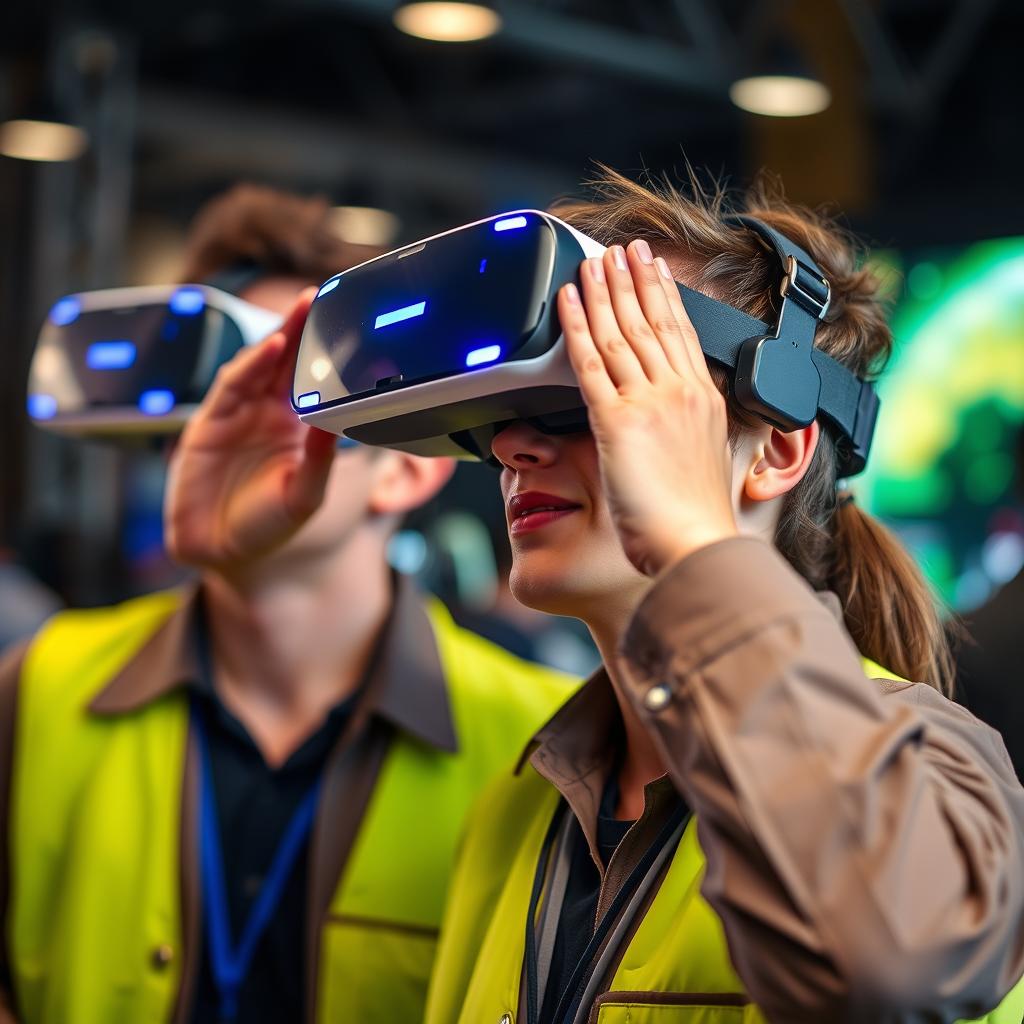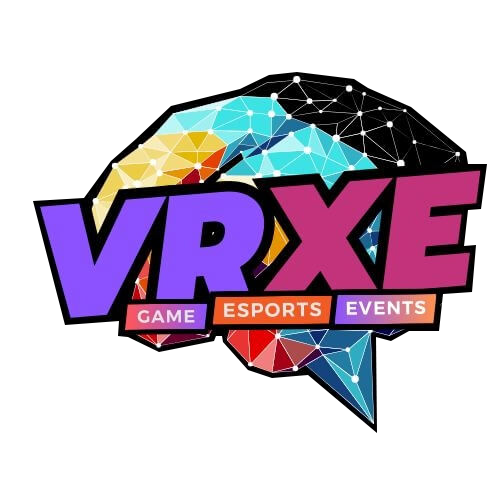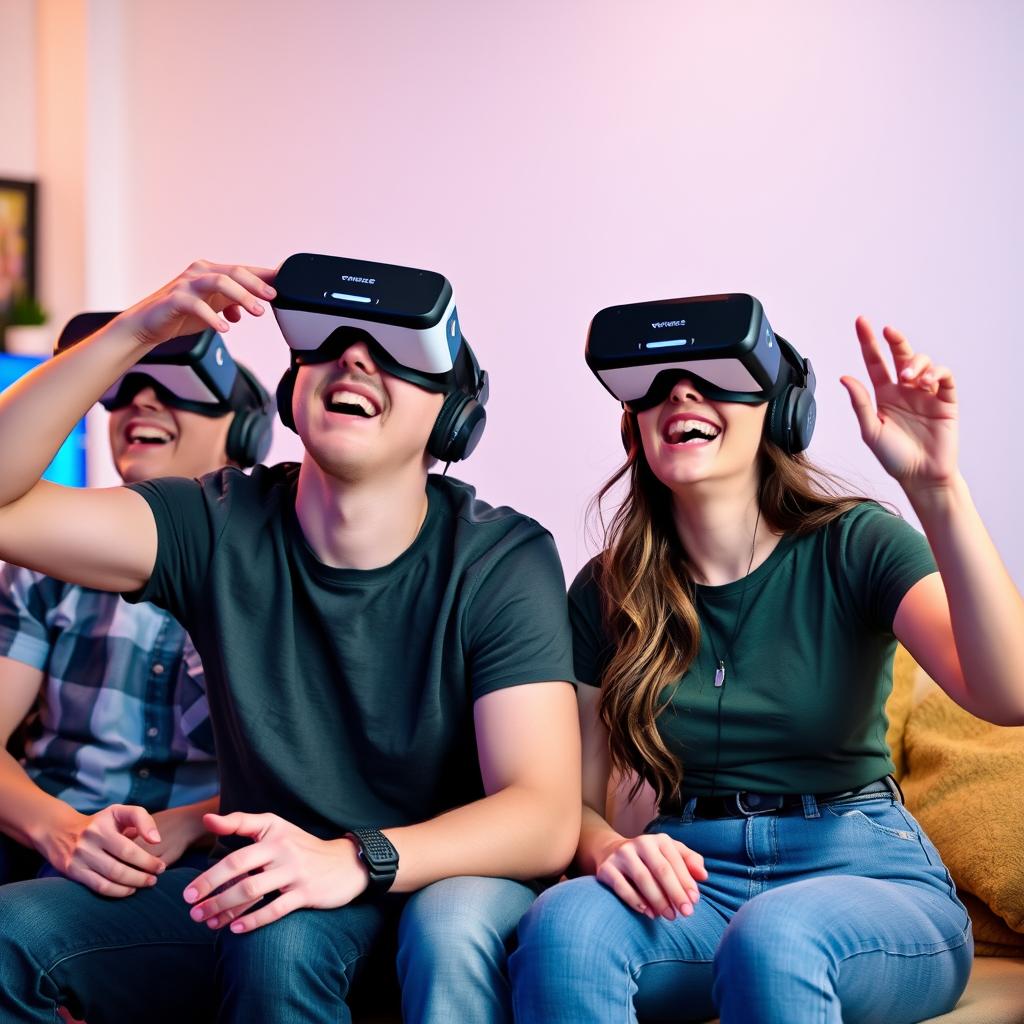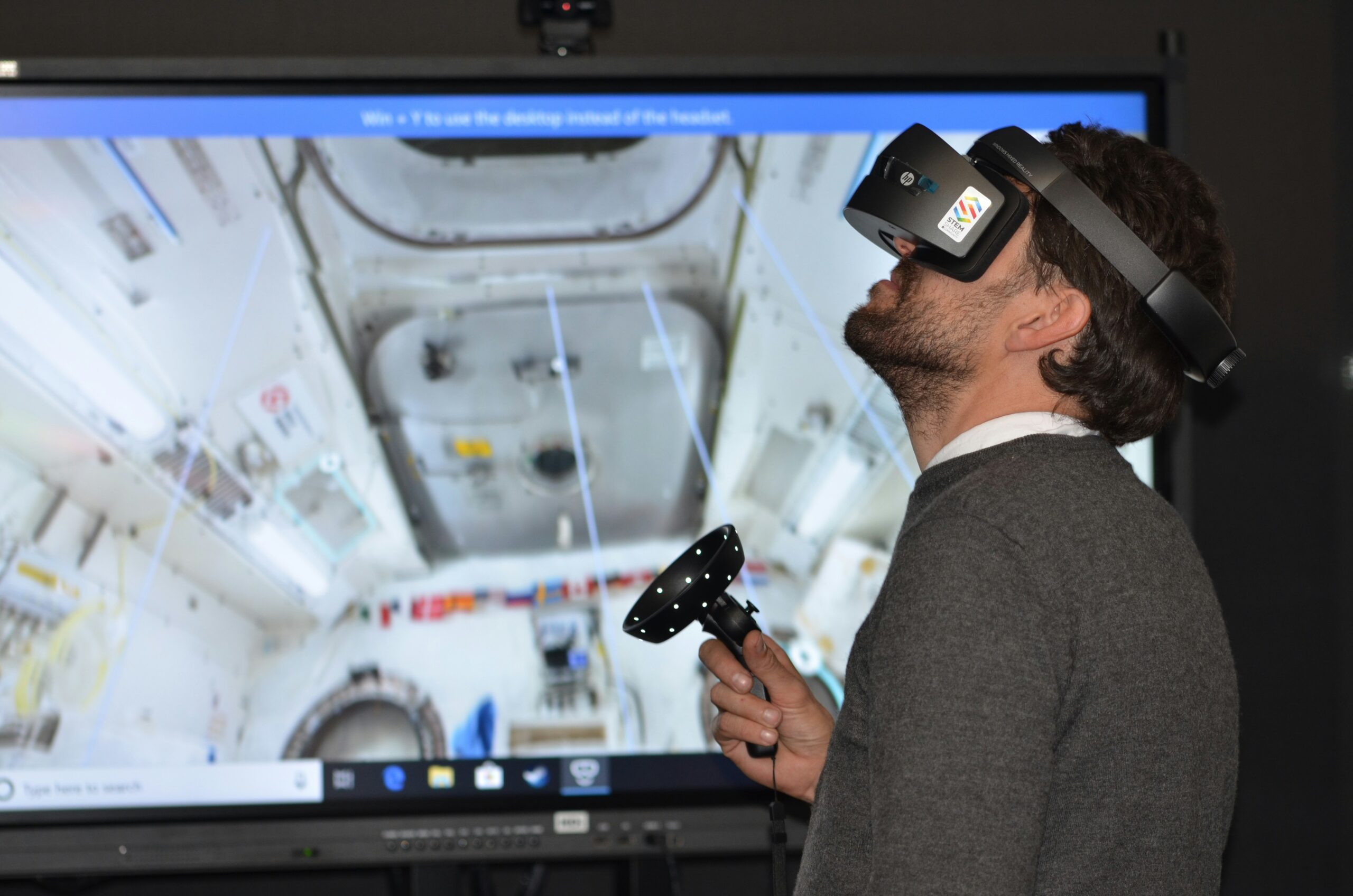
Virtual Reality (VR) has a wide range of applications across various industries and fields. Here are some of the key uses of VR:
1. Gaming and Entertainment
- Immersive Gaming: VR provides a fully immersive gaming experience, allowing players to interact with virtual environments in a more engaging way.
- Virtual Concerts and Events: VR enables users to attend live concerts, sports events, and other entertainment experiences from the comfort of their homes.
- Interactive Storytelling: VR is used to create immersive narratives where users can explore and interact with the story environment.
2. Education and Training
- Simulated Learning Environments: VR is used to create realistic simulations for training purposes, such as medical surgery, flight simulation, and military training.
- Virtual Field Trips: Students can explore historical sites, natural wonders, and other educational locations without leaving the classroom.
- Skill Development: VR can be used to teach complex skills, such as welding, plumbing, or even public speaking, in a controlled and repeatable environment.
3. Healthcare
- Medical Training: VR allows medical students and professionals to practice surgeries and other procedures in a risk-free virtual environment.
- Therapy and Rehabilitation: VR is used for physical therapy, helping patients recover from injuries by engaging in virtual exercises. It’s also used in psychological therapy, such as exposure therapy for PTSD or phobias.
- Pain Management: VR has been shown to help reduce pain and anxiety in patients undergoing painful treatments or recovering from surgery.
4. Real Estate and Architecture
- Virtual Property Tours: Potential buyers or renters can take virtual tours of properties without needing to visit in person.
- Architectural Visualization: Architects and designers use VR to create and explore 3D models of buildings and spaces before they are constructed, allowing for better design decisions and client presentations.
5. Retail and E-commerce
- Virtual Try-Ons: VR allows customers to try on clothes, accessories, or even makeup virtually before making a purchase.
- Virtual Stores: Retailers can create virtual storefronts where customers can browse and shop in a fully immersive environment.
6. Travel and Tourism
- Virtual Travel Experiences: Users can explore destinations around the world through VR, which is especially useful for planning trips or experiencing places that are difficult to visit.
- Cultural Preservation: VR can be used to create digital replicas of historical sites and artifacts, preserving them for future generations.
7. Work and Collaboration
- Remote Work: VR can create virtual office spaces where remote teams can collaborate in a more immersive and interactive way.
- Virtual Meetings: Instead of traditional video calls, VR meetings can provide a more engaging and interactive experience, with participants feeling as if they are in the same room.
8. Art and Design
- Virtual Art Galleries: Artists can showcase their work in virtual galleries, allowing people from around the world to view and interact with the art.
- 3D Modeling and Design: Designers and artists use VR to create and manipulate 3D models in a more intuitive and immersive way.
9. Social Interaction
- Virtual Social Spaces: VR platforms allow users to meet, interact, and socialize in virtual environments, creating new forms of social interaction and community building.
- Virtual Reality Chatrooms: Users can communicate with others in a more immersive and engaging way compared to traditional text or video chat.
10. Military and Defense
- Combat Training: VR is used to simulate combat scenarios for training soldiers in a safe and controlled environment.
- Mission Planning: Military personnel can use VR to visualize and plan missions, including terrain analysis and strategy development.
11. Sports
- Athlete Training: VR can be used to simulate game scenarios, allowing athletes to practice and improve their skills in a virtual environment.
- Fan Engagement: VR can provide fans with immersive experiences, such as watching a game from the perspective of a player or being in a virtual stadium.
12. Automotive Industry
- Vehicle Design: Car manufacturers use VR to design and test new vehicle models in a virtual environment before building physical prototypes.
- Driver Training: VR can simulate driving conditions for training purposes, helping new drivers learn in a safe and controlled setting.
13. Mental Health
- Stress Reduction: VR environments can be used for relaxation and stress reduction, offering immersive experiences like virtual nature walks or meditation spaces.
- Exposure Therapy: VR is used to treat anxiety disorders, phobias, and PTSD by gradually exposing patients to their fears in a controlled virtual environment.
14. Space Exploration
- Astronaut Training: VR is used to simulate space missions, helping astronauts prepare for the challenges of space travel.
- Public Engagement: VR can be used to educate and engage the public in space exploration, offering virtual tours of spacecraft, planets, and other celestial bodies.
15. Manufacturing and Engineering
- Product Prototyping: Engineers and designers use VR to create and test prototypes in a virtual environment, reducing the need for physical prototypes.
- Factory Layout Planning: VR can be used to design and optimize factory layouts, improving efficiency and safety.
16. Law Enforcement and Emergency Services
- Training Simulations: VR is used to train police officers, firefighters, and other emergency responders in realistic scenarios, such as hostage situations or natural disasters.
- Crime Scene Reconstruction: VR can be used to recreate crime scenes for investigation and courtroom presentations.
17. Cultural and Historical Preservation
- Virtual Museums: VR can create digital replicas of museums, allowing people to explore exhibits from anywhere in the world.
- Historical Reenactments: VR can be used to recreate historical events or places, providing an immersive educational experience.
18. Fitness and Wellness
- Virtual Workouts: VR fitness programs offer immersive exercise experiences, such as virtual cycling, boxing, or yoga classes.
- Mindfulness and Meditation: VR can create serene environments for mindfulness practices, helping users relax and focus.
19. Marketing and Advertising
- Immersive Brand Experiences: Companies use VR to create immersive brand experiences, allowing customers to interact with products or services in a virtual environment.
- Virtual Showrooms: Automakers and other industries use VR to showcase their products in virtual showrooms, providing an interactive and engaging experience for potential buyers.
20. Research and Development
- Scientific Visualization: Researchers use VR to visualize complex data, such as molecular structures or astronomical phenomena, in a more intuitive way.
- Behavioral Studies: VR is used in psychology and social science research to study human behavior in controlled virtual environments.
21. Accessibility
- Assistive Technology: VR can be used to create assistive technologies for people with disabilities, such as virtual mobility aids or communication tools.
- Inclusive Experiences: VR can provide experiences that are accessible to people with physical limitations, such as virtual travel or social interaction.
22. Environmental and Urban Planning
- Urban Development: Planners use VR to visualize and simulate urban development projects, helping to make informed decisions about city planning.
- Environmental Impact Studies: VR can be used to model and visualize the environmental impact of proposed projects, such as new construction or land use changes.
23. Culinary Arts
- Virtual Cooking Classes: VR can be used to teach cooking techniques in an immersive environment, allowing users to practice in a virtual kitchen.
- Menu Visualization: Restaurants can use VR to create virtual representations of their dishes, helping customers visualize their meals before ordering.
24. Fashion
- Virtual Fashion Shows: Designers can showcase their collections in virtual fashion shows, reaching a global audience without the need for physical events.
- Design and Prototyping: Fashion designers use VR to create and visualize new designs, allowing for rapid prototyping and iteration.
25. Journalism and Storytelling
- Immersive Journalism: VR allows journalists to create immersive stories, placing viewers in the middle of the action and providing a deeper understanding of the events.
- Documentary Filmmaking: VR documentaries offer a more engaging and immersive way to experience real-world stories and issues.
26. Music
- Virtual Concerts: Musicians can perform live in virtual venues, allowing fans to experience concerts from anywhere in the world.
- Music Production: VR can be used in music production to create and manipulate sounds in a virtual environment, offering new creative possibilities.
27. Theater and Performing Arts
- Virtual Performances: Theater companies and performers can use VR to create and stream virtual performances, reaching a wider audience.
- Set Design: VR can be used to design and visualize stage sets, allowing for more creative and efficient production processes.
28. Agriculture
- Farm Planning: VR can be used to visualize and plan farm layouts, optimizing crop placement and resource management.
- Training and Education: Farmers can use VR to learn new techniques and practices in a virtual environment, improving their skills and knowledge.
29. Energy and Utilities
- Infrastructure Planning: VR can be used to design and visualize energy infrastructure, such as power plants or wind farms, before construction begins.
- Safety Training: VR is used to train workers in the energy sector, simulating hazardous environments and emergency scenarios.
30. Telecommunications
- Network Visualization: Telecom companies use VR to visualize and manage complex network infrastructures, improving efficiency and troubleshooting.
- Customer Experience: VR can be used to create immersive customer experiences, such as virtual tours of data centers or interactive product demonstrations.
31. Legal and Judicial
- Virtual Courtrooms: VR can be used to conduct virtual court proceedings, allowing participants to attend from remote locations.
- Jury Simulation: VR can be used to simulate courtroom scenarios for jury research and training purposes.
32. Human Resources
- Virtual Onboarding: Companies can use VR to onboard new employees, providing immersive training and orientation experiences.
- Diversity and Inclusion Training: VR can be used to create empathy-building experiences, helping employees understand different perspectives and cultures.
33. Non-Profit and Social Impact
- Awareness Campaigns: Non-profits use VR to create immersive experiences that raise awareness about social issues, such as poverty, climate change, or human rights.
- Fundraising: VR can be used to create compelling virtual experiences that engage donors and encourage contributions.
34. Event Planning
- Virtual Event Spaces: Event planners can use VR to create virtual venues for conferences, trade shows, and other events, allowing attendees to participate remotely.
- Event Visualization: VR can be used to visualize and plan event layouts, ensuring optimal space utilization and attendee experience.
35. Crisis Management
- Disaster Simulation: VR can be used to simulate natural disasters or other crises, helping emergency responders and planners prepare for real-world scenarios.
- Crisis Communication: VR can be used to train communication teams in managing crisis situations, such as public relations during a disaster.
36. Personal Development
- Virtual Coaching: VR can be used for personal coaching, such as life coaching, career coaching, or fitness coaching, providing immersive and interactive sessions.
- Self-Improvement: VR can offer experiences designed to help users develop new skills, overcome fears, or improve their mental well-being.
37. Gastronomy
- Virtual Dining Experiences: Restaurants can offer virtual dining experiences, where customers can enjoy meals in immersive virtual environments.
- Culinary Exploration: VR can be used to explore different cuisines and cooking techniques from around the world, offering a unique educational experience.
38. Language Learning
- Immersive Language Practice: VR can create immersive environments for language learners to practice speaking and listening in realistic scenarios.
- Cultural Immersion: VR can help language learners experience the culture associated with the language they are studying, enhancing their understanding and fluency.
39. Child Development
- Educational Games: VR can be used to create educational games that help children learn and develop skills in a fun and engaging way.
- Therapeutic Applications: VR can be used in child therapy, such as helping children with autism develop social skills or providing relaxation techniques for anxiety.
40. Aging and Elder Care
- Cognitive Training: VR can be used to provide cognitive training for older adults, helping to maintain or improve mental acuity.
- Virtual Companionship: VR can offer social interaction and companionship for elderly individuals, reducing feelings of loneliness and isolation.
41. Transportation
- Driverless Vehicle Testing: VR can be used to simulate and test autonomous vehicles in a variety of driving conditions and scenarios.
- Public Transport Planning: VR can help urban planners design and optimize public transportation systems, improving efficiency and user experience.
42. Insurance
- Risk Assessment: VR can be used to simulate and assess risks, such as natural disasters or accidents, helping insurers make more informed decisions.
- Claims Processing: VR can be used to visualize and assess damage for insurance claims, such as in the case of car accidents or property damage.
43. Pharmaceuticals
- Drug Development: VR can be used to visualize and simulate the effects of new drugs at the molecular level, aiding in the development process.
- Patient Education: VR can be used to educate patients about their medications and treatments, providing a more engaging and understandable experience.
44. Construction
- Virtual Site Inspections: Construction managers can use VR to conduct virtual site inspections, identifying potential issues before they become problems.
- Safety Training: VR can be used to train construction workers in safety procedures, simulating hazardous situations in a controlled environment.
45. Logistics and Supply Chain
- Warehouse Design: VR can be used to design and optimize warehouse layouts, improving efficiency and reducing costs.
- Supply Chain Visualization: VR can help visualize and manage complex supply chains, identifying bottlenecks and optimizing processes.
46. Publishing
- Interactive Books: VR can be used to create interactive books, where readers can explore and interact with the story in a virtual environment.
- Virtual Libraries: VR can create virtual libraries, allowing users to browse and read books in an immersive digital space.
47. Advertising
- Immersive Ad Campaigns: Brands can use VR to create immersive advertising campaigns, allowing consumers to interact with products in a virtual environment.
- Virtual Product Demos: Companies can use VR to create virtual product demonstrations, showcasing features and benefits in an engaging way.
48. Crisis Simulation
- Emergency Response Training: VR can be used to train emergency responders in crisis situations, such as natural disasters or terrorist attacks.
- Corporate Crisis Management: Companies can use VR to simulate and prepare for potential crises, such as data breaches or public relations disasters.
49. Virtual Tourism
- Destination Previews: VR can be used to provide virtual previews of travel destinations, helping tourists plan their trips and choose accommodations.
- Cultural Experiences: VR can offer immersive cultural experiences, such as virtual tours of museums, historical sites, or cultural festivals.
50. Personal Entertainment
- Virtual Cinema: VR can be used to create virtual cinemas, where users can watch movies in an immersive environment.
- Virtual Reality Arcades: VR arcades offer a variety of immersive games and experiences, providing entertainment for individuals and groups.
Conclusion
The applications of VR are vast and continue to expand as technology advances. From entertainment and education to healthcare and industry, VR is transforming how we interact with the world and each other, offering new possibilities for innovation and engagement.


